
Edward Winter

The present article chiefly concerns the Sicilian Defence line 1 e4 c5 2 b4.
The moves 1 e4 c5 2 b4 go back to the seventeenth century (Greco), but at least two more recent masters have claimed parenthood. On pages 232-233 of Chess Novelties (London, 1895) Bird gave this game under the heading ‘Bird’s Wing Attack’:
Henry Edward Bird – H.
Occasion?
Sicilian Defence
1 e4 c5 2 b4 e5 3 f4 d6 4 Nf3 Bg4 5 Bc4 Nc6 6 O-O Nd4 7 Nxd4 Bxd1 8 Bb5+ Ke7 9 Nf5+ Ke6 10 Nc3 cxb4 11 Nd5 Nf6 and White mated in two moves.
Marshall too was to seek credit. On page 120 of his book Chess Masterpieces (New York, 1928) he wrote of 2 b4: ‘I believe this move is my own invention. It may not be absolutely sound, but it always leads to an interesting game, affording plenty of opportunities for attack.’
This may be contrasted with Napier’s low opinion of the opening (given in Lasker’s Chess Magazine, March 1906, page 211):
‘Known “to the Trade” as the wing gambit. It is easily defined as capital offence against common sense in chess. It is comparable with pitching one’s young to the crocodiles, so the devil may not get them. Black justifiably puts the pawn in his pocket. If out of the troubled waters that ensue he fishes nothing, it is because he fishes ill in the shallows.’
Another ‘Wing Gambit’ is 1 e4 e6 2 Nf3 d5 3 e5 c5 4 b4 (see, for example, page 235 of The Sorcerer’s Apprentice by D. Bronstein and T. Fürstenberg). The databases that we have been able to check contain no pre-1960s examples, except for a case by transposition: 1 e4 c5 2 Nf3 e6 3 b4 cxb4 4 d4 d5 5 e5 Nc6 (P. Keres v A. Remmelgas, Correspondence game, 1935). However, the game below appeared on pages 44-45 of the January 1898 BCM:
Henry Holwell Cole – P.R. Clifford
Telephone match, 18 December 1897
French Defence
1 e4 e6 2 Nf3 d5 3 e5 c5 4 b4 cxb4 5 d4 Nc6 6 Bd3 h6 7 O-O Bd7 8 Be3 Nge7 9 Nh4 g5 10 Nf3 Qc7 11 a3 Nf5 12 axb4 Bxb4 13 c3 Ba5 14 Qb3 Nxe3 15 fxe3 Bb6 16 Na3 Na5 17 Qb2 Nc4 18 Bxc4 dxc4 19 Nd2 O-O 20 Rf6 Kg7 21 Raf1 Qc6 22 Naxc4 Bd8 23 R6f2 f5 24 exf6+ Bxf6 25 Qa3 Rae8 26 Ne5 Be7 27 Rxf8 Resigns.
If no other nineteenth-century specimens come to light would ‘Cole’s Gambit’ be a good name for the 1 e4 e6 2 Nf3 d5 3 e5 c5 4 b4 line?
(2217)
A strange combinative game:
William M. de Visser – Walter Penn Shipley
Manhattan v Franklin Team Match, New York, 1900
Sicilian Defence
1 e4 c5 2 b4 cxb4 3 a3 e5 4 Nf3 Nc6 5 axb4 Bxb4 6 Bc4 Nf6 7 Qe2 O-O 8 O-O d5 9 exd5 Nxd5 10 Nxe5 Nd4 11 Qd3 Nf4 12 Qe4 Nfe2+ 13 Bxe2 Bf5 14 Qe3 Nxc2 15 Qf4 Nxa1 16 Qxf5 Qc7 17 Bb2 Nb3 18 Bd3 g6
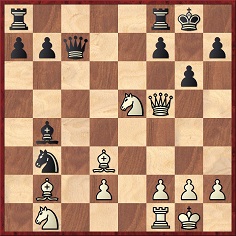
19 Ng4 Bc3 20 Qf6 Bxf6 21 Nxf6+ Kg7 22 Ne8+ Kg8 23 Nxc7 Rad8 24 Be4 Nxd2 25 Nxd2 Rxd2 26 Bc3 Re2 27 Nd5 f5 28 Bd3 Ra2 29 Bc4 Ra4 30 Ne7 mate.
Source: BCM, September 1900, pages 377-378.
In his annotations, which the BCM reproduced from the Brooklyn Daily Eagle, de Visser called 2 b4 the ‘Garrat Wing Gambit’ (on what grounds?). He thought that at move 12 Shipley was ‘a little too enterprising’ and that Black could have secured an even game with 12…Be6. After the game Shipley acknowledged that he had missed 15 Qf4, believing 15 Qb3 to be forced. De Visser considered that 16…Qd4 would have been better than 16…Qc7 but he also criticized his own 19th move, calling 19 Qf6 ‘much more conclusive’ (e.g. 19…Be7 20 Qh8+ Kxh8 21 Nxf7+ Kg8 22 Nh6 mate).
(2384)
Per Skjoldager (Fredericia, Denmark) provides the following report from the Rigasche Zeitung of 10 February 1912 (new style):
‘On 22 January 1912 the American chessmaster gave a simultaneous display in the Pernauer Schachklub (+22 –0 =1). On 25 January there followed an exhibition in the Rigaer Schachverein (+23 –2 =10). On 26 January Marshall played a serious game against the local master A. Ni[e]mzowitsch which ended in a draw after interesting play. On 27 January, in the Mitauer Schachklub, Marshall won all 18 games. On 28 January a small display was given in the Rigaer Börsen Café (+12 –2 =1).’
Our correspondent also supplies this game:
Frank James Marshall (simultaneous) – A. Grünlaub
Riga, 25 January 1912
Sicilian Defence
1 e4 c5 2 b4 e6 3 bxc5 Bxc5 4 d4 Bb6 5 c3 Ne7 6 Bd3 Nbc6 7 Qg4 h5 8 Qg3 Nxd4 9 Na3 Ndc6 10 Nb5 Ng6 11 Bg5 h4
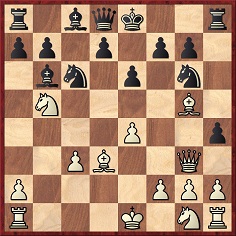
12 Bxd8 hxg3 13 Bxb6 Rxh2 14 Nc7+ Ke7 15 Nxa8 Rxh1 16 O-O-O axb6 17 fxg3 Nge5 18 Be2 Rh2 19 Nxb6 Na7 20 Nf3 Nxf3 21 Bxf3 Rh8 22 e5 Nc6 23 Bxc6 bxc6 24 c4 Kd8 25 c5 Rh5 26 Re1 f6 27 Kd2 Ba6 28 Re4 Rxe5 29 Rxe5 fxe5 30 Ke3 Kc7 31 Ke4 d6 32 Na8+ Kd7 33 Nb6+ Drawn.
Source: Rigasche Zeitung, 10 February 1912.
(2864)
Hartogh Heijs – Prins
Occasion?
English Opening
1 c4 c5 2 b4 cxb4 3 d4 e6 4 Nd2 d5 5 cxd5 exd5 6 e4 dxe4 7 Nxe4 Qd5 8 Qe2 Qxd4 9 Bb2 Qb6
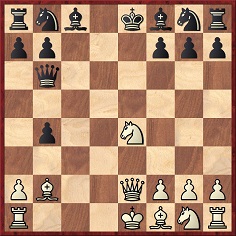
White announced mate in four moves.
Source: Schaakkalender van het Noordelijk Schaakbond 1883, pages 87-88.
(2998)
See Unknown Games.
From Rick Kennedy (Columbus, OH, USA):
‘On pages 68-69 of A Chess Omnibus the article “Wing gambits” presented the game W.M. de Visser v W.P. Shipley, Manhattan v Franklin Team Match, 30 May 1900 with annotations by de Visser from the September 1900 BCM (taken from the Brooklyn Daily Eagle), which called 1 e4 c5 2 b4 the “Garrat Wing Gambit”. You asked what the grounds were for this name, and I now have a possible answer.
The Chess Digest booklet Sicilian Wing Gambit: A Historical Survey by James J. Romeo (circa 1982) discusses the de Visser v Shipley game with the following historical note on pages 5-6:
“In this game, de Visser plays the Full-Wing. As far back as Greco, the move P-QR3 is thematic in the Wing Gambit, but it was not played immediately on the third move until the end of the 1800s. In his notes to the game, de Visser makes the comment that this opening is known as the Garrat Wing Gambit, and played quite often by H.E. Bird. Although de Visser mistakes the old German script S (for Sarratt) for a G (which it looks like), at least by the turn of the century it was recognized that Bird was merely an advocate of the opening, and not its discoverer.”
Earlier in this History chapter (page 4), Romeo wrote:
“1813 – J.H. Sarratt. In this book, Sarratt translates chess treatises by Damiano, Ruy López, and Salvio, and augments this material with his own analysis. As an appendix to this work, Sarratt includes four games from the 1623 Greco Manuscript ...”
Romeo’s explanation appears to be his own assessment, as he gives no source, but it is plausible.’
Jeremy Silman (Los Angeles, CA, USA) asks about the circumstances of Capablanca’s loss to Roy T. Black at New York in 1911 (a Sicilian Wing Gambit).
Contrary to appearances, the game was played, on 25 January 1911, in a serious event: the national tournament in New York. From page 50 of the March 1911 American Chess Bulletin:
‘Capablanca lost only one game, in the fourth round, when he was opposed to R.T. Black, of Brooklyn. Against him, Capablanca, before he had really settled down to serious work, played a gambit variation of the Sicilian Defense, a course he had reason to regret. It was surprising to find Capablanca, after six games, with a score of 3½ to 2½, yet such was the case and it required six successive wins in the remaining rounds to enable him to get as close to Marshall as he did.’
The same issue (pages 56-57) had the game against R.T. Black, with annotations by Walter Penn Shipley:
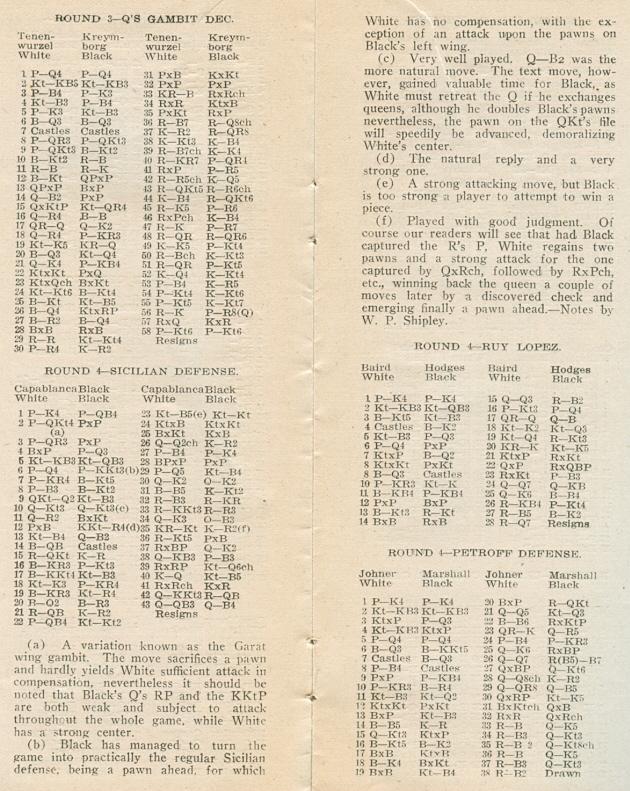
Among the few books to have annotated the game are Capablancas Verlustpartien by Fritz C. Görschen (Hamburg, 1976) and the first volume of the ‘Chess Stars’ anthology on Capablanca (Sofia, 1997).
The Cuban, for his part, gave this account towards the end of Chapter IV of My Chess Career (London, 1920):
‘In the winter of 1910-1911 I made another tour of the US. A tournament was arranged in New York, which I entered with the idea of practising for the coming tournament at San Sebastian. The New York tournament started in January. I rode on a train 27 hours straight from Indianapolis, the last city of my tournée, to New York. I arrived at nine in the morning and had to start at eleven the same day, and play every day thereafter. I was so fatigued that I played badly during the first part of the contest. Half of it was over and I was yet in fifth place, though the only opponent of real calibre was Marshall. I finally began to play better, and by winning five [six, in fact] consecutive games finished second to Marshall.’
(6239)
Frank James Marshall, Léonardus Nardus and B. Hallegua –
M.D. Altintope, de Cramer and A. Téléguine
Paris, 10 April 1914
Sicilian Defence
1 e4 c5 2 b4 cxb4 3 a3 d5 4 e5 Nc6 5 d4 e6 6 axb4 Bxb4+ 7 c3 Ba5 8 Qg4 Nge7 9 Bd3 Ng6 10 Nf3 Qc7 11 O-O Bd7 12 Ba3 Nce7 13 Bd6 Qd8 14 Bxe7 Kxe7 15 h4 h5 16 Qg5+ Kf8 17 Bxg6 fxg6 18 Qxg6 Rh6 19 Qg3 Bb6 20 Ng5 Qe7 21 f4 g6 22 Nd2 Kg7
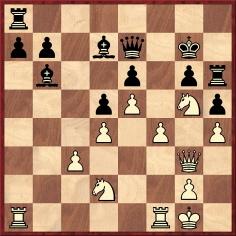
23 f5 exf5 24 Rfb1 Rf8 25 e6 Bc6 26 Rxb6 axb6 27 Qe5+ Rf6 28 c4 dxc4 29 d5 Qc5+ 30 Kh2 Qxd5 31 Qc7+ Kf8 32 Ra8+ Be8 33 e7+ Kg7 34 Rxe8 Rc6
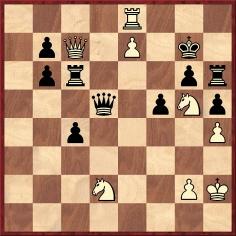
35 Rg8+ Qxg8 36 Qe5+ Resigns.
Source: La Stratégie, April 1914, pages 164-165 (with brief notes by Marshall).
From Adrian Harvey (Edgware, England) comes a request for information about Victor Buerger (later: Berger).
Buerger defeated Alekhine at Margate, 1937 in a game which featured ‘the worst blunder ever seen on a chessboard’, according to Irving Chernev on page 77 of Wonders and Curiosities of Chess (New York, 1974). The game was presented with notes (‘based on post-play analysis and discussion by the contestants themselves’) on pages 281-283 of CHESS, 14 April 1937, with the sequence 36...Qxf4 37 Nxe4 described as ‘probably the most incredible double oversight in the history of first-class chess’.
Relatively little information is available at Buerger, who died in 1996 (BCM, May 1996, page 259). He was the subject of a tribute article by William Winter on pages 302-305 of CHESS, 14 April 1936, which included Buerger’s win over Bogoljubow at Scarborough, 1927 and referred to his victories against Colle and Réti. It was noted too that ‘Buerger, der Ideenreiche’ was Tartakower’s phrase in Neue Schachsterne (Vienna, 1935); see pages 14-18, which include Buerger’s short victory over Sir George Thomas at Hastings, 1926-27.
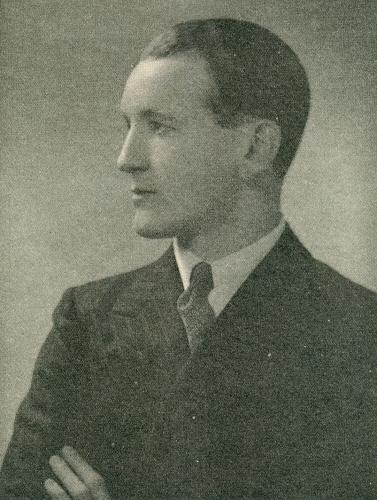
Victor Buerger in CHESS, 14 April 1936, page 303
An interesting claim made by William Winter on Buerger’s behalf:
‘He has chased the Wing Gambit completely off the board by his variation (first played against Yates in 1926) 1 P-K4 P-QB4 2 P-QKt4 PxP 3 P-QR3 P-Q4! 4 P-K5 Kt-QB3 5 P-Q4 Q-B2! 6 Kt-KB3 B-Kt5, in which Black secures an equal development with a safe pawn ahead.’
Below is the full game, from page 70 of the Chess Amateur, December 1926 and pages 66-67 of The “British Chess Magazine” Chess Annual 1926 by M.E. Goldstein (Leeds, 1927):
F.D. Yates – Victor Buerger1 e4 c5 2 b4 cxb4 3 a3 d5 4 e5 Nc6 5 d4 Qc7 6 Nf3 Bg4
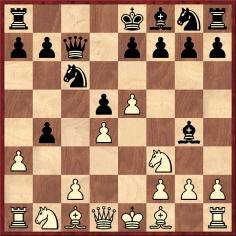
7 axb4 Nxb4 8 c3 Nc6 9 Na3 a6 10 Be2 e6 11 O-O Rd8 12 Qa4 Ne7 13 Be3 Nc8 14 Rfb1 Bf5 15 Rb2 Be7 16 Nc2 O-O 17 Bd2 Nb8 18 Qb3 b5 19 Nb4 Bxb4 20 cxb4 Nb6 21 Rc1 Nc4 22 Bg5 Rc8 23 Ra2 Qb7 24 Raa1 Rc6 25 Nh4 Bg6 26 Qg3 Rc7 27 Bg4 Nc6 28 Qc3 a5 29 Nxg6 axb4 30 Qd3 hxg6 31 Rab1 Ra8 32 Rd1 Ra3 33 Qe2 Qa7 34 Be3 b3 35 h4 b2 36 Kh2 Ra1 37 Qe1 Rxb1 38 Rxb1 Qa2 39 Be2 Na3 40 Bd3 Nxb1 41 Bxb1 Qa1 42 h5 gxh5 43 Qf1
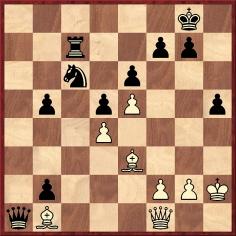
43...Nxe5 44 dxe5 Rc1 45 White resigns.
The game may be found in databases with White’s 14th move given as 14 Rab1, but both our sources state that the king’s rook was moved.
(6387)
From pages 15-16 of Wonders and Curiosities of Chess by Irving Chernev (New York, 1974):
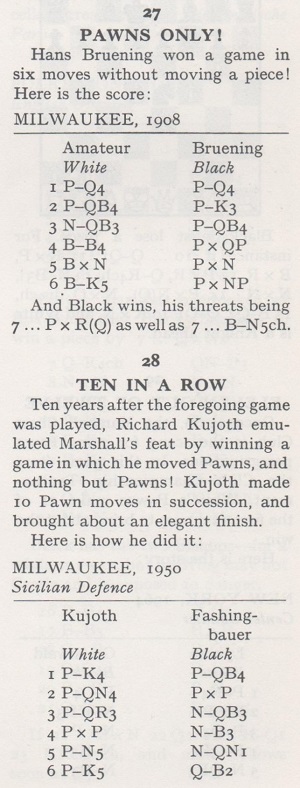
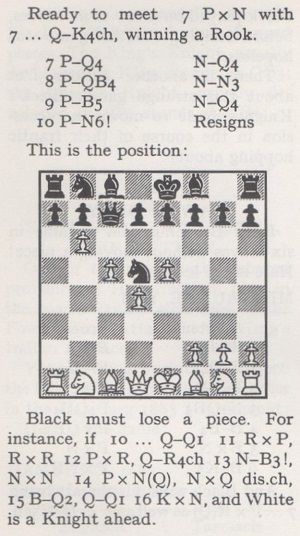
The game N.N. v Bruening was discussed in C.N. 4638.
Regarding Kujoth v Fashingbauer, we have received the following from Mark Erickson (Richland, WA, USA):
‘Andrew Soltis’s “Chess to Enjoy” column on pages 12-13 of the April 2009 Chess Life, entitled “The Hoax is on You”, included the famous miniature Kujoth v Fashingbauer, Milwaukee, 1950 (1 e4 c5 ... 10 b6 “and Black resigned on move 16”) and stated:
“When the game was published, some Europeans laughed at the rather obvious hoax ...” (Soltis cast particular doubt on Black’s name.)
The letters column on page 6 of the August 2009 Chess Life printed a reply from Kujoth. He reported that his book Chess is an Art had two games against John Fashingbauer, and he made some odd statements:
- “The second game, involving ten-consecutive-pawn moves in the Wing Gambit ...” In fact, that was the first of his two games against Fashingbauer given in Chess is an Art (ten-pawn-move game: 1950, game 39; the other game: 1951, game 40);
- Without consulting Kujoth, a columnist named Averill Powers had truncated the well-known game from 28 moves to ten in his column, entitled “The Game of Kings” in the Milwaukee Journal of 21 May 1950. Kujoth also asserted, without further explanation: “I have just completed a discussion with Myron Katz, attorney at law in Milwaukee.”
In his response on the same page of the August 2009 Chess Life, Soltis gave a 28-move version of the Sicilian Defense game supplied by Kujoth (“his original handwritten score of the game”). The issues of Chess Life can be read on-line.
Nonetheless, in his own book, Chess is an Art, published much earlier, Kujoth himself had stated that Black resigned at move ten. From pages 106-107:
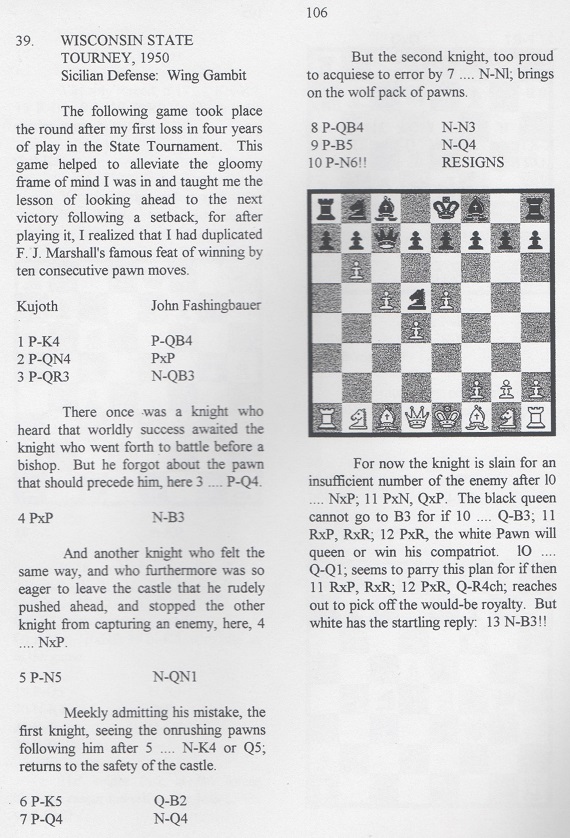
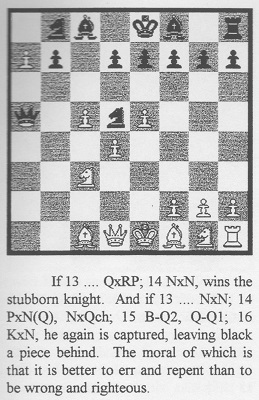
Moreover, in his Introduction to the book Kujoth referred approvingly to two works, by Chernev and Sokolsky, which had given the ten-move version.
Why did Kujoth change his position in 2009, denying that the game had lasted only ten moves?’
The title page of the book referred to by Mr Erickson:
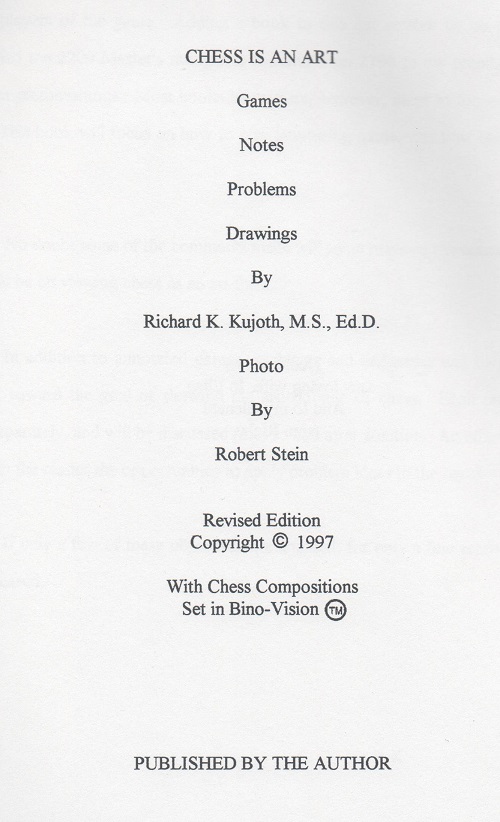
We have this edition (where the games against Fashingbauer, numbers 37 and 38, are on pages 47-49):
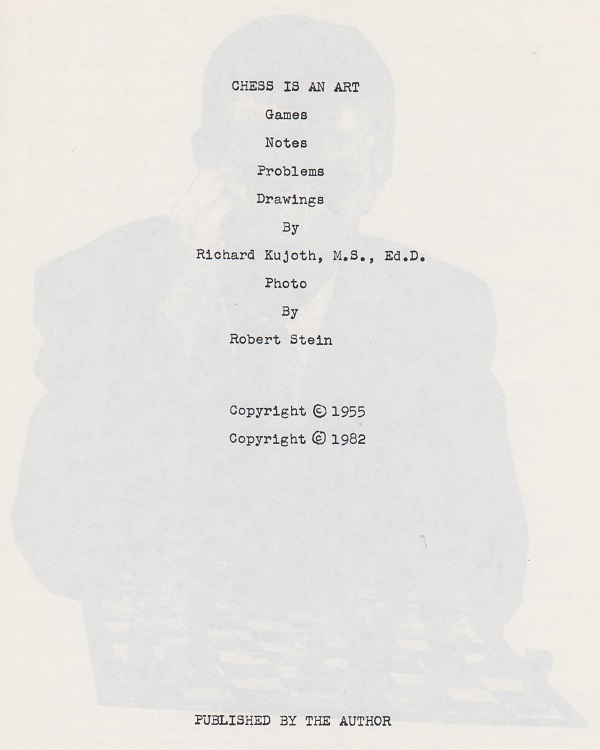
The 21 May 1950 Milwaukee Journal column has yet to be found.
(11790)
See also The Sicilian Defence.
Latest update: 30 March 2025.
To the Chess Notes main page.
To the Archives for other feature articles.
Copyright: Edward Winter. All rights reserved.